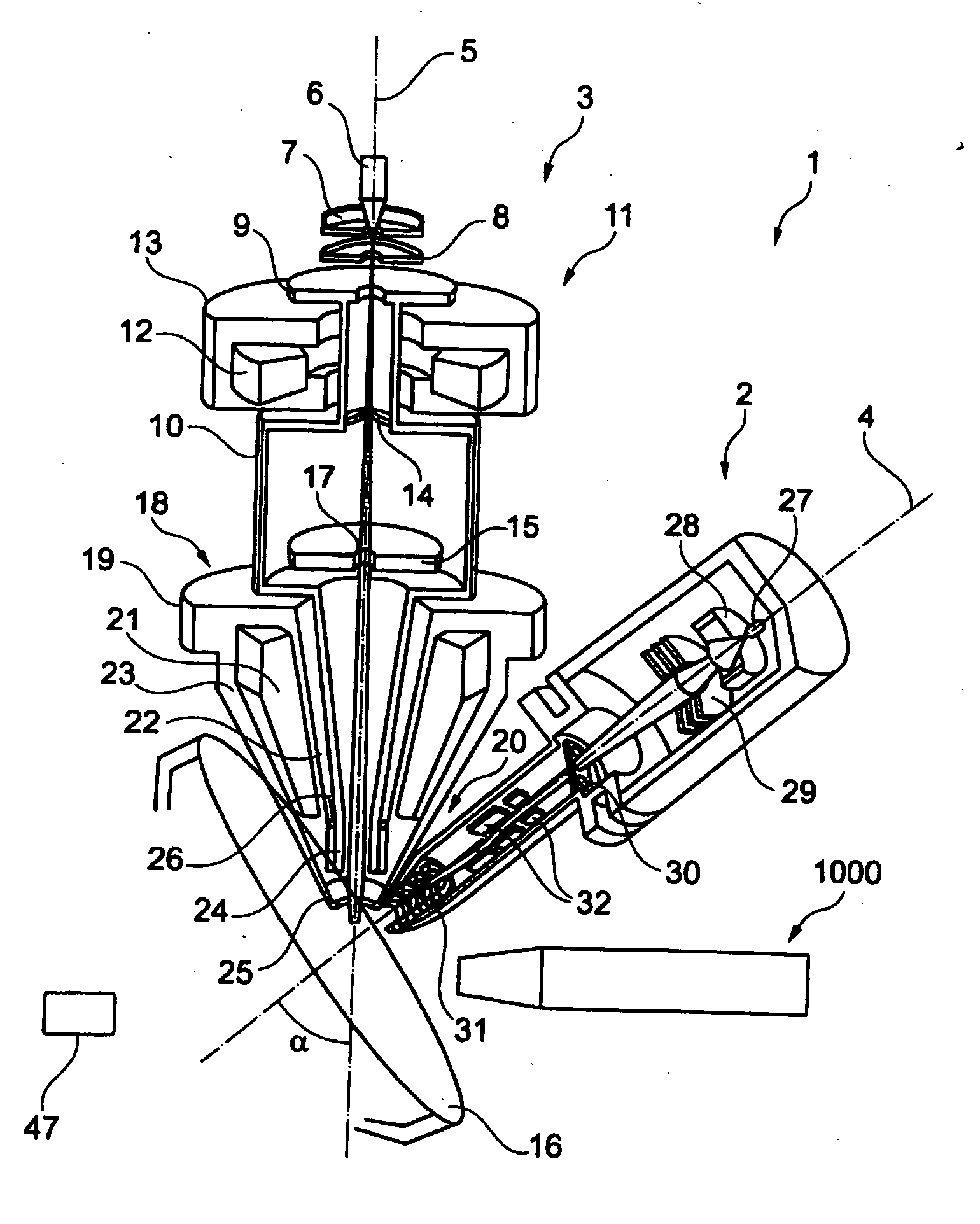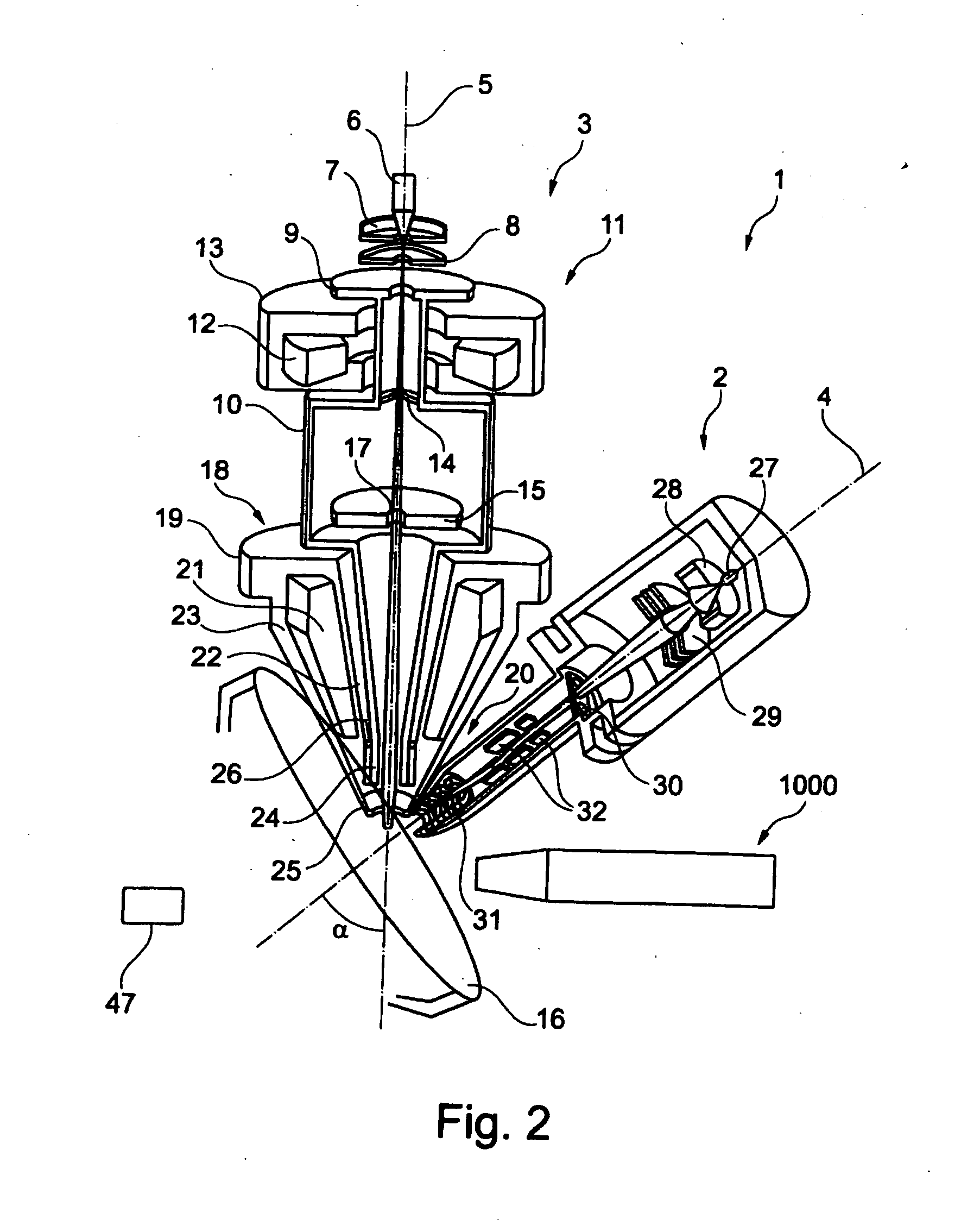[0025]The impacts of the ions with the gas particles may reduce the radial component of the
kinetic energy, thus reducing the amplitude, as already mentioned above, of the
macro-oscillation, and the ions may be focused on the transport axis of the container. The axial component of the
kinetic energy ensures that the ions pass through the container along the transport axis of the container in the direction of an analysis unit. However, the abovementioned impacts may also decrease the axial component of the kinetic energy, as a result of which the energy of some ions is no longer sufficient to pass completely through the container as far as an analysis unit. A
potential gradient is therefore provided on the container. The ions may be moved axially in the direction of the analysis unit by the
potential gradient. The potential gradient may be designed such that the potential decreases continuously in the direction of an analysis unit, and has a
potential well in the area of one end of the container, which is directed at an analysis unit. The ions may pass through the container and in the process transmit their energy to the gas particles, until they rest in the
potential well.
[0026]The first multipole alternating field, for example the first
quadrupole alternating field, and the second multipole alternating field, for example the second
quadrupole alternating field, may be formed electrically by the first
printed circuit board and the second
printed circuit board. As already mentioned above, the
system described herein provides, for example, for the first multipole alternating field and the second multipole alternating field to be identical. It is advantageous for the apparatus according to the
system described herein to be of simple design, and for it to be possible to connect its elements easily. Contact is made with individual elements on the first
printed circuit board and on the second printed circuit board via conductor tracks which are arranged in the first printed circuit board and in the second printed circuit board. For example, four first printed circuit board electrodes can be used op the first printed circuit board, and / or four second printed circuit board electrodes on the second printed circuit board. Other embodiments provide for the use of more than four first printed circuit board electrodes and / or four second printed circuit board electrodes, for example 8 or 16 first printed circuit board electrodes and / or 8 or 16 second printed circuit board electrodes.
[0030]According to the
system described herein, the container may have a free internal area which is considerably larger than a free internal area of a container which is used in systems from the prior art, which systems have
quadrupole units in the form of bar electrodes. The larger free internal area may ensure that even ions with large
macro-oscillations and large micro-oscillations can be stored without them striking the multipole units. In the case of the system described herein, each multipole unit may include a plurality of printed circuit board electrodes which are at a distance from the transport axis. With the container having the same maximum external dimensions as the prior art, the system described herein therefore makes it possible to provide a large internal area in the container, with a
radius (core
radius) which is available for free propagation of the ions.
[0032]Yet another embodiment of the apparatus according to the system described herein additionally or alternatively provides for the internal area to be circular and to have a
radius (core radius). Provision may also be made for the first multipole unit and / or the second multipole unit to have a longitudinal extent in the direction of the transport axis which, for example, corresponds to the radius, or essentially to the radius. The first multipole unit and the second multipole unit may each be in the form of a segment. As mentioned above, the length of individual segments may be oriented on the core radius. Since the core radius can be chosen to be greater than a core radius of an apparatus from the prior art, this reduces the number of segments required and which should be arranged along a predeterminable distance on the transport axis. This is a further
advantage of the system described herein.
[0048]The above transport apparatus according to the system described herein may be particularly suitable for transporting to an analysis unit the ions which have been braked to a
thermal energy after energy has been transmitted from an ion to gas particles. In particular, the transport apparatus according to the system described herein may ensure that ions which are arranged in a
potential well are transported to an analysis unit. This may be done by moving the potential well axially along the transport axis of the container. The movement may be produced by the first potential and the second potential, which can be predetermined appropriately. No kinetic energy is supplied to the ions with this form of transport. They may remain focused both axially and radially with respect to the transport axis. This makes it easier to inject the ions into an analysis unit.
 Login to View More
Login to View More  Login to View More
Login to View More 


